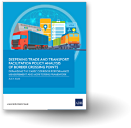Bangladesh needs to export more to neighboring markets
A growing convergence between agricultural and non-agricultural wages is observed in recent years in Bangladesh. A national survey conducted in 2010 by Bangladesh Bureau of Statistics (BBS) indicates equality between wages of agricultural and unskilled industrial worker. In terms of economic terminology, this equality is known as “Lewsian turning point”. In plain words, it means current manufacturing wage has to be increased to relocate more workers from agriculture to industrial sector. Therefore, further industrialization would result in monotonic increase of wages both at rural and urban sectors.
The process of industrialization in Bangladesh is led by the ready-made garments sector. Although the industry is criticized for paying too little to workers, the minimum wage of the sector is about 109 percent of country’s average per capita Gross Domestic Product (GDP).
There are very few countries where minimum wage accounts for more than 100 per cent of per capita income. Due to the advent of Lewsian turning point in the economy and continued domestic and international scrutiny, the manufacturing wage in Bangladesh is likely to increase at a faster rate in the future.
Cross-country experiences indicate that a country (i) increases its export to neighboring and regional markets, and /or (ii) improves its trade logistics to reduce the trade cost to withstand the effects of rising wages and to maintain its external competitiveness. The improvement in Bangladesh’s external competitiveness lies with these strategies as well.
While efforts to improve trade logistics are ongoing in Bangladesh and also require time and resources, the country can complement these efforts and benefit even in the immediate term by increasing its exports to neighboring markets. This would require less time and money, and commodities can be shipped more timely and reliably. This is particularly important for Bangladesh as Indian economy is growing fast—accounting for 1.25 percent of world GDP in 1991 which increased to 2.8 percent in 2011—providing export opportunities to its neighbors. Same logic holds in the case of the People’s Republic of China as well.
However, Bangladesh’s export to India, albeit increasing in the recent years, is still very low compared to its export to the western markets. India accounted for less than 3 percent and more than 15 percent of Bangladesh’s total export and import respectively, positioning itself as 10th largest export destination and 2nd largest import source markets of Bangladesh. There are urgent and longstanding concerns in Bangladesh about the perennial, large bilateral trade deficit with India.
India accounts for more than fourth-fifths of South Asia’s total GDP. Sustained high economic growth of the country has increased the potential for intra-region trade potentials. But while South Asia’s integration with the rest of the world has been increasing over time, the region as a whole has so far failed to pluck the low-hanging fruits of its own backyard.
The analysis of export statistics indicates an unusual trade profile between Bangladesh and India. Bangladesh can be characterized as a labor exporting country. It exports goods and services, either processed in the form of labor-intensive merchandize exports like basic garments or/and unprocessed in the form of export of natural persons which bring remittances (mode 4 according to WTO).
However, Bangladesh does not export any unprocessed labor to India and the nature of its merchandize export to India notably differs from the overriding nature of country’s overall exports. While the primary products account for a little part of Bangladesh’s overall merchandize exports to the rest of the world, their dominance in country’s export to India is notably high.
New products account for most of Bangladesh’s export to India. In contrast, most of Bangladesh’s overall export impetus during 2001-11 period came from the consolidation of export of existing items. However, inclusion of new items in the export basket played a relatively larger role in the case of Bangladesh’s export to India.
Along with the inclusion of new commodities in the export basket, the relative share of different commodities in Bangladesh’s total export to India has changed. Out of the top ten Bangladeshi exports to India in 2001, four failed to retain their position in 2011, whereas in the case of Bangladesh’s export to world market, the top ten exports remained unchanged for more than a decade.
These mean that consolidation of current export strengths may suffice to increase Bangladesh’s total exports to the rest of the world in the foreseeable future. In case of its exports to India, the pace of the growth will depend on its ability to diversify into the export of new products in response to emerging opportunities in Indian market. Related to this, to fully exploit the emerging opportunities, Bangladesh needs to improve its own production and delivery capacity.
*Researcher, Bangladesh Institute of Development Studies (BIDS), former economist, World Bank, and former faculty, Willamette University, USA




